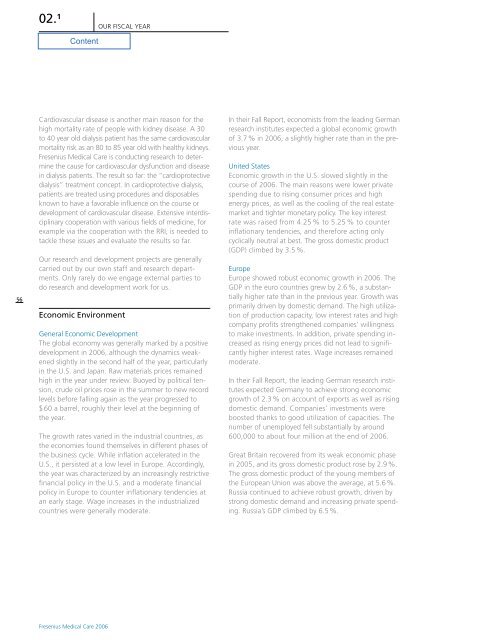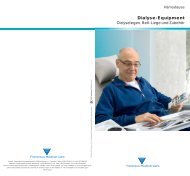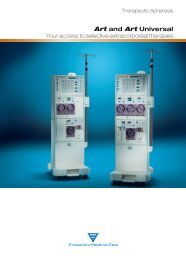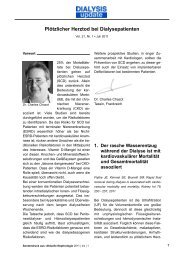Operations and Business Environment - Fresenius Medical Care
Operations and Business Environment - Fresenius Medical Care
Operations and Business Environment - Fresenius Medical Care
Create successful ePaper yourself
Turn your PDF publications into a flip-book with our unique Google optimized e-Paper software.
02. 1 Our Fiscal year<br />
56<br />
Cardiovascular disease is another main reason for the<br />
high mortality rate of people with kidney disease. A 30<br />
to 40 year old dialysis patient has the same cardiovascular<br />
mortality risk as an 80 to 85 year old with healthy kidneys.<br />
<strong>Fresenius</strong> <strong>Medical</strong> <strong>Care</strong> is conducting research to determine<br />
the cause for cardiovascular dysfunction <strong>and</strong> disease<br />
in dialysis patients. The result so far: the “cardioprotective<br />
dialysis” treatment concept. In cardioprotective dialysis,<br />
patients are treated using procedures <strong>and</strong> disposables<br />
known to have a favorable influence on the course or<br />
development of cardiovascular disease. Extensive interdisciplinary<br />
cooperation with various fields of medicine, for<br />
example via the cooperation with the RRI, is needed to<br />
tackle these issues <strong>and</strong> evaluate the results so far.<br />
Our research <strong>and</strong> development projects are generally<br />
carried out by our own staff <strong>and</strong> research departments.<br />
Only rarely do we engage external parties to<br />
do research <strong>and</strong> development work for us.<br />
Economic <strong>Environment</strong><br />
General Economic Development<br />
The global economy was generally marked by a positive<br />
development in 2006, although the dynamics weakened<br />
slightly in the second half of the year, particularly<br />
in the U.S. <strong>and</strong> Japan. Raw materials prices remained<br />
high in the year under review. Buoyed by political tension,<br />
crude oil prices rose in the summer to new record<br />
levels before falling again as the year progressed to<br />
$ 60 a barrel, roughly their level at the beginning of<br />
the year.<br />
The growth rates varied in the industrial countries, as<br />
the economies found themselves in different phases of<br />
the business cycle. While inflation accelerated in the<br />
U.S., it persisted at a low level in Europe. Accordingly,<br />
the year was characterized by an increasingly restrictive<br />
financial policy in the U.S. <strong>and</strong> a moderate financial<br />
policy in Europe to counter inflationary tendencies at<br />
an early stage. Wage increases in the industrialized<br />
countries were generally moderate.<br />
In their Fall Report, economists from the leading German<br />
research institutes expected a global economic growth<br />
of 3.7 % in 2006, a slightly higher rate than in the previous<br />
year.<br />
United States<br />
Economic growth in the U.S. slowed slightly in the<br />
course of 2006. The main reasons were lower private<br />
spending due to rising consumer prices <strong>and</strong> high<br />
energy prices, as well as the cooling of the real estate<br />
market <strong>and</strong> tighter monetary policy. The key interest<br />
rate was raised from 4.25 % to 5.25 % to counter<br />
inflationary tendencies, <strong>and</strong> therefore acting only<br />
cyclically neutral at best. The gross domestic product<br />
(GDP) climbed by 3.5 %.<br />
Europe<br />
Europe showed robust economic growth in 2006. The<br />
GDP in the euro countries grew by 2.6 %, a substantially<br />
higher rate than in the previous year. Growth was<br />
primarily driven by domestic dem<strong>and</strong>. The high utilization<br />
of production capacity, low interest rates <strong>and</strong> high<br />
company profits strengthened companies’ willingness<br />
to make investments. In addition, private spending increased<br />
as rising energy prices did not lead to significantly<br />
higher interest rates. Wage increases remained<br />
moderate.<br />
In their Fall Report, the leading German research institutes<br />
expected Germany to achieve strong economic<br />
growth of 2.3 % on account of exports as well as rising<br />
domestic dem<strong>and</strong>. Companies’ investments were<br />
boosted thanks to good utilization of capacities. The<br />
number of unemployed fell substantially by around<br />
600,000 to about four million at the end of 2006.<br />
Great Britain recovered from its weak economic phase<br />
in 2005, <strong>and</strong> its gross domestic product rose by 2.9 %.<br />
The gross domestic product of the young members of<br />
the European Union was above the average, at 5.6 %.<br />
Russia continued to achieve robust growth, driven by<br />
strong domestic dem<strong>and</strong> <strong>and</strong> increasing private spending.<br />
Russia’s GDP climbed by 6.5 %.<br />
<strong>Fresenius</strong> <strong>Medical</strong> <strong>Care</strong> 2006








